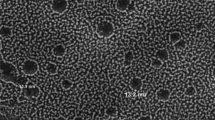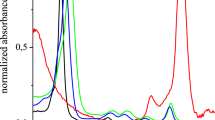Abstract
At the present time, photodynamic inactivation (PDI) is receiving considerable interest for its potential as an antimicrobial therapy. The results of our study indicate that enhancement of the phototoxic effect on Pseudomonas aeruginosa can be achieved by combination of tetrasulfonated hydroxyaluminum phthalocyanine (AlPcS4) and bimetallic gold/silver nanoparticles (Au/Ag-NPs) synthesized by the cell-free filtrate of Aureobasidium pullulans. The bimetallic nanoparticles were characterized by a number of techniques including UV-vis, XPS, TEM, and SEM-EDS to be 14 ± 3 nm spherical particles coated with proteins. The effect of diode lasers with the peak-power wavelength ʎ = 650 nm (output power of 10 and 40 mW; radiation intensity of 26 and 105 mW/cm2) in combination with the AlPcS4 and the bimetallic nanoparticles mixture on the viability of P. aeruginosa rods was shown. Particularly high efficiency of killing bacterial cells was obtained for the light intensity of 105 mW/cm2, after 20, 30, and 40 min of irradiation corresponding to 126, 189, and 252 J/cm2 energy fluences. For AlPcS4+Au/Ag-NPs treatment, the viable count reduction were equal to 99.90, 99.96, and 99.975%, respectively. These results were significantly better than those accomplished for irradiated separated assays of AlPcS4 and Au/Ag-NPs.








Similar content being viewed by others
References
Peleg AY, Hooper DC (2010) Hospital-acquired infections due to Gram-negative bacteria. N Engl J Med 362:1804–1813
Sydnor ERM, Perl TM (2011) Hospital epidemiology and infection control in acute-care settings. Clin Microbiol Rev 24:141–173
World Health Organization (2014) Antimicrobial resistance: global report on surveillance
Dai T, Huang YY, Hamblin MR (2009) Photodynamic therapy for localized infections—state of the art. Photodiagn Photodyn Ther 6:170–188
Konopka K, Goslinski T (2007) Photodynamic therapy in dentistry. J Dent Res 86:694–707
Liu P-F, Zhu W-H, Huang C-M (2009) Vaccines and photodynamic therapies for oral microbial-related diseases. Curr Drug Metab 10:90–94
Rajesh S, Koshi E, Philip K, Mohan A (2011) Antimicrobial photodynamic therapy: an overview. J Indian Soc Periodontol 15:323–327
Maisch T, Szeimies RM, Jori G, Abels C (2004) Antibacterial photodynamic therapy in dermatology. Photochem Photobiol Sci 3:907–917
Maisch T, Hackbarth S, Regensburger J, Felgenträger A, Bäumler W, Landthaler M, Röder B (2011) Photodynamic inactivation of multi-resistant bacteria (PIB)—a new approach to treat superficial infections in the 21st century. J Dtsch Dermatol Ges 9:360–366
Smijs TG, Pavel S (2011) The susceptibility of dermatophytes to photodynamic treatment with special focus on Trichophyton rubrum. Photochem Photobiol 87:2–13
Lewańska M, Olszewska D, Godela A, Myga-Nowak M, Kuberska M (2016) Selected aspects of combat drug-resistance bacteria. Chem Environ Biotechnol 19:79–85
Aveline B (2001) Primary processes in photosensitization mechanisms. Compre Ser Photosci 2:17–34
Hamblin MR, Hasan T (2004) Photodynamic therapy: a new antimicrobial approach to infectious disease? Photochem Photobiol Sci 3:436–450
Baltazar LM, Ray A, Santos DA, Cisalpino PS, Friedman AJ, Nosanchuk JD (2015) Antimicrobial photodynamic therapy: an effective alternative approach to control fungal infections. Front Microbiol 6:202
Spagnul C, Turner LC, Boyle RW (2015) Immobilized photosensitizers for antimicrobial applications. J Photochem Photobiol B: Biol 150:11–30
Malik Z, Ladan H, Nitzan Y (1992) Photodynamic inactivation of Gram-negative bacteria: problems and possible solutions. J Photochem Photobiol B 14:262–266
Segalla A, Borsarelli CD, Braslavsky SE, Spikes JD, Roncucci G, Dei D, Chiti G, Jori G, Reddi E (2002) Photophysical, photochemical and antibacterial photosensitizing properties of a novel octacationic Zn(II)-phthalocyanine. Photochem Photobiol Sci 1:641–648
Nikaido H (1994) Prevention of drug access to bacterial targets: permeability barrier and active efflux. Science 264:362–368
Yoshimura F, Nikaido H (1985) Diffusion of beta-lactam antibiotics through the porin channels of Escherichia coli K-12. Antimicrob Agents Chemother 27:84–92
Bertoloni G, Rossi F, Valduga G, Jori G, van Lier J (1990) Photosensitizing activity of water- and lipid-soluble phthalocyanines on Escherichia coli. FEMS Microbiol Lett 59:149–155
Storm DR, Rosenthal KS, Swanson PE (1977) Polymyxin and related peptide antibiotics. Annu Rev Biochem 46:723–763
Soukos NS, Ximenez-Fyvie LA, Hamblin MR, Socransky SS, Hasan T (1998) Targeted antimicrobial photochemotherapy. Antimicrob Agents Chemother 42:2595–2601
Grafe S, Gebhardt P, Albrecht V (2004) Siderophore conjugates of photoactive dyes for photodynamic therapy. Patent US20040186087
Narband N, Mubarak M, Ready D, Parkin IP, Nair SP, Green MA et al (2008) Quantum dots as enhancers of the efficacy of bacterial lethal photosensitization. Nanotechnology 19:445102
Paszko E, Ehrhardt C, Senge MO, Kelleher DP, Reynolds JV (2011) Nanodrug applications in photodynamic therapy. Photodiagn Photodyn Ther 8:14–29
Masilela N, Antunes E, Nyokong T (2013) Axial coordination of zinc and silicon phthalocyanines to silver and gold nanoparticles: an investigation of their photophysicochemical and antimicrobial behavior. J Porphyrins Phthalocyanines 17:417–430
Jijie R, Dumych T, Chengnan L, Bouckaert J, Turcheniuk K, Hage CH et al (2016) Particle-based photodynamic therapy based on indocyanine green modified plasmonic nanostructures for inactivation of a Crohn’s disease-associated Escherichia coli strain. J Mater Chem B 4:2598–2605
Kendall CA, Morton CA (2003) Photodynamic therapy for the treatment of skin disease. Technol Cancer Res Treat 2:283–288
Moan J, Peng Q, Sorensen R, Iani V, Nesland JM (1998) The biophysical foundations of photodynamic therapy. Endoscopy 30:387–391
Wharton T, Gali H, Hamblin MR (2009) Photosensitizers for targeted photodynamic therapy. Patent US20090076115
Palewska K, Sujka M, Urasińska-Wójcik B, Sworakowski J, Lipiński J, Nešpůrek S, Rakušan J, Karásková M (2008) Light-induced effects in sulfonated aluminum phthalocyanines—potential photosensitizers in the photodynamic therapy. Spectroscopic and kinetic study. J Photochem Photobiol A Chem 197:1–12
Crist BV (1999) Handbooks of monochromatic XPS spectra; Vol. 1 and 2, B. XPS International, Inc
Green SK, Schroth MN, Cho JJ, Kominos SK, Vitanza-Jack VB (1974) Agricultural plants and soil as a reservoir for Pseudomonas aeruginosa. Appl Microbiol 28:987–991
Glazebrook JS, Campbell RS, Hutchinson GW, Stallman ND (1978) Rodent zoonoses in North Queensland: the occurrence and distribution of zoonotic infections in North Queensland rodents. Aust J Exp Biol Med Sci 56:147–156
Williams PA, Worsey MJ (1976) Ubiquity of plasmids in coding for toluene and xylene metabolism in soil bacteria: evidence for the existence of new TOL plasmids. J Bacteriol 125:818–828
Lyczak JB, Cannon CL, Pier GB (2000) Establishment of Pseudomonas aeruginosa infection: lessons from a versatile opportunist. Microbes Infect 2:1051–1060
Wróblewska M (2006) Novel therapies of multidrug-resistant Pseudomonas aeruginosa and Acinetobacter spp.infections: the state of the art. Arch Immunol Ther Exp 54:113–120
Kim YJ, Jun YH, Kim YR, Park KG, Park YJ, Kang JY, Kim SI (2014) Risk factors for mortality in patients with Pseudomonas aeruginosa bacteremia; retrospective study of impact of combination antimicrobial therapy. BMC Infect Dis 14:161
Tomás JG, Tubby S, Parkin IP, Narband N, Dekker L, Nair SP, Wilson M, Street C (2007) Lethal photosensitisation of Staphylococcus aureus using a toluidine blue O–tiopronin–gold nanoparticle conjugate. J Mater Chem 17:3739–3746
Perni S, Piccirillo C, Pratten J, Prokopovich P, Chrzanowski W, Parkin IP, Wilson M (2009) The antimicrobial properties of light-activated polymers containing methylene blue and gold nanoparticles. Biomaterials 30:89–93
Maliszewska I, Leśniewska A, Olesiak-Bańska J, Matczyszyn K, Samoć M (2014) Biogenic gold nanoparticles enhance methylene blue-induced phototoxic effect on Staphylococcus epidermidis. J Nanopart Res 16:2457
Spikers JD (1986) Phtalocyanines as photosensitizers in biological systems and for photodynamic therapy of tumors. Photochem Photobiol 43:691–699
Glassberg E, Lewandowski L, Lask G, Uitto J (1990) Laser-induced photodynamic therapy with aluminum phthalocyanine tetrasulfonate as the photosensitizer: differential phototoxicity in normal and malignant human cells in vitro. J Invest Dermtol 94:604–610
Iqbal CJ, Chen Z, Huang M (2015) Phtalocyanine-biomolecule conjugated photosensitizers for targeted photodynamic therapy and imaging. Curr Drug Metabol 16:816–832
Liz-Marzan LM (2004) Nanometals formation and color. Mater Today 7:26–31
Mahl D, Diendorf J, Ristig S, Greulich C, Li Z-A, Farle M, Koöller M, Epple M (2012) Silver, gold, and alloyed silver–gold nanoparticles: characterization and comparative cell-biologic action. J Nanopart Res 14:1153
Shankar SS, Rai A, Ahmad A, Sastry M (2004) Rapid synthesis of Au, Ag, and bimetallic Au core–Ag shell nanoparticles using neem (Azadirachta indica) leaf broth. J Colloid Interface Sci 275:496–502
Senapati S, Ahmad A, Khan MI, Sastry M, Kumar R (2005) Extracellular biosynthesis of bimetallic Au–Ag alloy nanoparticles. Small 1:517–520
Kittler S, Greulich C, Diendorf J, Köller M, Epple M (2010) Toxicity of silver nanoparticles increases during storage because of slow dissolution under release of silver ions. Chem Mater 22:4548–4554
Li T, Albee B, Alemayehu M, Diaz R, Ingham L, Kamal S, Rodriguez M, Bishnoi SW (2010) Comparative toxicity study of Ag, Au, and Ag–Au bimetallic nanoparticles on Daphnia magna. Anal Bioanal Chem 398:689–700
Greulich C, Braun D, Peetsch A, Diendorf J, Siebers B, Epple M, Koller M (2012) The toxic effect of silver ions and silver nanoparticles towards bacteria and human cells occurs in the same concentration range. RSC Adv 2:6981–6987
Kuruppuarachchi M, Savoie H, Lowry A, Alonso C, Boyle RW (2011) Polyacrylamide nanoparticles as a delivery system in photodynamic therapy. Mol Pharm 8:920–931
Li L, Zhao J-F, Won N, Jin H, Kim S, Chen J-Y (2012) Quantum dot-aluminum phthalocyanine conjugates perform photodynamic reactions to kill cancer cells via fluorescence resonance energy transfer. Nanoscale Res Lett 7:386
Funding
Project supported by Wroclaw Centre of Biotechnology, programme The Leading National Research Centre (KNOW) for years 2014–2018.
Author information
Authors and Affiliations
Corresponding author
Rights and permissions
About this article
Cite this article
Maliszewska, I., Kałas, W., Wysokińska, E. et al. Enhancement of photo-bactericidal effect of tetrasulfonated hydroxyaluminum phthalocyanine on Pseudomonas aeruginosa . Lasers Med Sci 33, 79–88 (2018). https://doi.org/10.1007/s10103-017-2337-0
Received:
Accepted:
Published:
Issue Date:
DOI: https://doi.org/10.1007/s10103-017-2337-0




